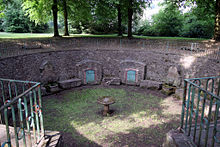Goethe Fountain (Bensheim)
The Goethe fountain , also called Gesund fountain , is a fountain system built in 1784 in the Bensheim - Auerbach prince camp . The plant is an under monument protection standing cultural monument .
Location and history
Coming from Bensheim-Auerbach, the Goethebrunnen is located just before Hochstädten - but still on the Auerbach district - a few meters to the right of the L 3103 (Mühltalstraße) behind a bridge that leads to the so-called Marmorit factory.
The Auerbach pastor Zwickwolf wrote as early as 1739 that “people from Darmstadt, Frankfurt, Heidelberg, Mannheim and even across the Rhine and Main in large flocks” had come to Auerbach to fetch the healing water in jugs and barrels. In 1769 the court medic and spa doctor JH Lichtenberg attributed a healing effect to the water. In the meantime, Landgrave Ludwig VIII of Hessen-Darmstadt discovered the place for his court and founded the royal camp. The fountain was probably built in 1784 at the request of the Hessian hereditary prince . The "great time" of the Auerbach medicinal water began. However, it only lasted almost 50 years. Around 1930 the spring then dried up almost completely. It is assumed that the cause is related to the neighboring underground mining of the Hochstädter marmorite works.
In addition to the fountain at the manor house in the Roßbach, the Goethe fountain is the second fountain of the prince camp.
A document in the Hessisches Staatsarchiv Darmstadt (HADIS) from 1768 shows:
Accurate floor plan of two health wells, one in the Hochstätter Valley, the other in Roßbach, both in the Auerbach district and the surrounding area.
A renovation of the Goethe Fountain was planned for 2006, but this was postponed for cost reasons. The current costs for the renovation are estimated at 150,000 euros.
construction
The well is circular and excavated at a depth of about two meters. To the west there is a staircase that leads down to the fountain. In the middle of the fountain is a round sandstone table . There are two well rooms directly opposite the stairs . Next to it are the actual wall fountains, which represent lion heads made of yellow sandstone and from whose mouth the water flows very sparsely (drop by drop). The date of the year 1784 is located in the lintel above the two well rooms. The water outlet is located directly next to the staircase. An iron railing protects visitors from falling into the fountain, presumably since the renovation in 1961.
Goethe and the Gesundbrunnen
In his work Hermann und Dorothea , Goethe describes a fountain that is very similar to this healthy fountain. It is therefore assumed that this fountain was known to Johann Wolfgang von Goethe .
Individual evidence
- ^ KJ Bänker: Between Auerbach and Hochstädten, a gem is falling into disrepair. ( Memento of the original from January 11, 2012 in the Internet Archive ) Info: The archive link was inserted automatically and has not yet been checked. Please check the original and archive link according to the instructions and then remove this notice. In: Bergsträßer Anzeiger , edition of May 20, 2008
- ↑ a b c State Office for Monument Preservation Hesse: Gesundbrunnen, Goethebrunnen , accessed on May 29, 2008
- ↑ a b K. J. Bänker: How rich in minerals is the water? ( Page no longer available , search in web archives ) Info: The link was automatically marked as defective. Please check the link according to the instructions and then remove this notice. In: Bergsträßer Anzeiger , edition of May 27, 2008
- ↑ In 2013 the renovation was completed.
Web links
- State Office for Monument Preservation Hessen (Ed.): Gesundbrunnen, Goethebrunnen In: DenkXweb, online edition of cultural monuments in Hessen
- Goethe fountain as a stumbling block Report in Echo-Online from April 21, 2010
Coordinates: 49 ° 42 '26.1 " N , 8 ° 38' 48.8" E







